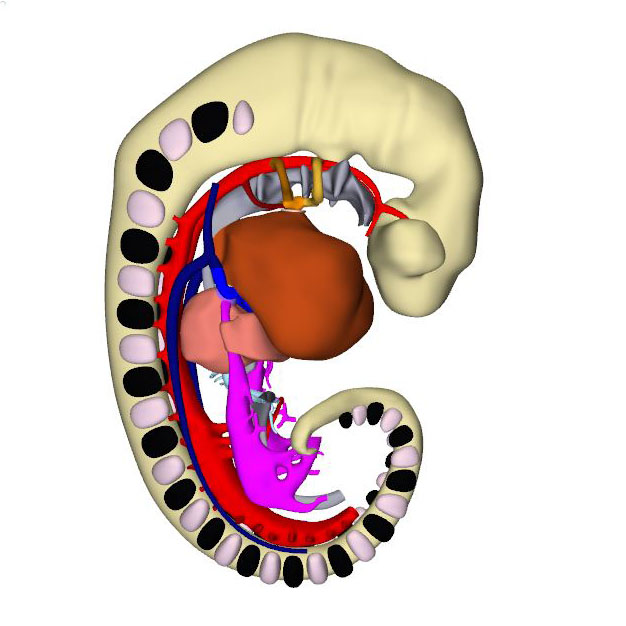
Back |
Interactive 3D PDF of Carnegie Stage 13 |
The interactive PDF below has been very kindly provided by Dr. Jill PJM Hikspoors, Prof. Wouter H Lamers,
Department of Anatomy & Embryology, Maastricht University, Maastricht, The Netherlands
Contact: jill.hikspoors@maastrichtuniversity.nl
Publication: 10.1038/s42003-022-03153-x
*Important* Although some web browsers will allow PDFs to be viewed online, the file must be downloaded and saved to a computer to enable the interactive options.
 |
 |
 |
 |
 |
||||
Right-sided view |
Ventral view: Neural tube illustrating the helical body shape |
Dorsal right view: Myocardium on the venous sinus |
Dorsal right view: Sinuatrial junction (right) and pulmonary vein (left) |
Right sagittal view: endocardial cushions within left-sided AV canal |
||||
 |
 |
 |
||||
Right view: Pharyngeal arch arteries |
Cranial view: Shape of the myocardial outflow tract |
Cranial view: Lumen of the myocardial outflow tract surrounded by endocardial jelly |
Caudal view: Changing position of the right ventricle |
This stage, reached at ~32 days after conception, is considered “phylotypic”. This is because morphologic features and profiles of gene expression are most similar among vertebrate embryos at this stage. Due to dorsal growth in its sacral region, first noticeable at CS12, the embryonic body axis assumes a helical shape, with the tail region typically on the right side of the body. The heart, within its pericardial cavity, remains surrounded by the transverse septum, the pharynx, and the forebrain. Due to the rapid growth of the brain and foregut between CS9 and CS14, the transverse septum gradually changes in orientation from frontal at CS9 to near-transverse at CS11. It also “descends” from ~6 somite lengths cranial to the first somite at CS9 to somite #8 at CS13, representing ~3 somites per Carnegie stage. The large caudal veins remain symmetrical in terms of their size, but the vitelline veins have by now been incorporated into the developing liver. The course of the common cardinal veins has changed, following the elongation of the foregut, from being transverse to longitudinal. It is no longer possible to recognize the proepicardial organs, but epicardium is now spreading over the surface of the heart, accumulating in the atrioventricular and interventricular grooves. We show only the thick layer of epicardium in the grooves in our reconstructions.
Myocardium has appeared on the epicardial side of the asymmetrically expanding systemic venous sinus, permitting the definition of the sinus horns. In mice, the myocardial walls of the horns differ from those of the atrial chambers and the pulmonary vein in developing from an Nkx2-5-negative, Tbx18-positive lineage. By this stage, furthermore, the systemic venous sinus drains exclusively into the right side of the atrial chambers through the right-sided sinuatrial junction. The stem of the left-sided, solitary pulmonary vein now exits the left atrium through the dorsal mesocardium, but is still blind-ending. Between CS12 and CS13, a subpopulation of endocardial cells undergoes endocardial-to-mesenchymal transformation and colonizes the endocardial jelly. This results in the appearance of cellularized endocardial cushions superiorly and inferiorly within the left-sided atrioventricular canal, with the cushions having atrial extensions that encircle the wide interatrial junction. This junction is known as the primary atrial foramen. The myocardial trabeculations remain more advanced in the embryonic left than the right ventricle, while the muscular ventricular septum is no more than a shallow ridge. The cavity of the outflow tract remains surrounded by endocardial jelly, with its smooth-walled myocardial wall extending distally to reach the pericardial reflection. The lumen of the outflow tract then continues via the aortic sac and arteries of the pharyngeal arches to the paired dorsal aortas. There are now 3 pharyngeal pouches, which interpose between 4 arches. The 1st pair of pharyngeal arch arteries has disappeared, whereas arteries have formed in the 3rd and 4th arches.
Click an image to download a 3D-PDF. The file must be saved to a computer to enable the interactive options. The 3D-PDFs can be opened on any computer as long as Adobe PDF or equivalent reader is installed.
A 3D-PDF becomes activated by “clicking” with the mouse on the reconstruction.
A toolbar appears at the top of the screen that includes the option “model tree”.
The model tree displays a material list of structures in the upper box, and preset viewing options (cameras) in the lower box. The sequence of items corresponds to that in Supplemental Table 3 of the publication.
The list of visible structures can be modified by marking or unmarking a structure.
To manipulate the reconstruction, press the left mouse button to rotate it, the scroll button to zoom in or out, and the left and right mouse buttons simultaneously to move the embryo across the screen.
A structure can be rendered transparent by selecting that option from the drop-down menu after selecting the structure with the right mouse button.
To inspect a combination of structures, one is advised to build up the composition, beginning with a familiar component, such as a lumen, rather than deleting non-relevant structures one-by-one from a completely reconstructed specimen.
The slicer button in the toolbar allows making cross sections. The plane of section can be adjusted with the offset and tilt options.
The “loop wires” in Supplemental Figures 3-6 of the publication, which are drawn through the center of the endocardial heart tube, emphasize the changing shape of the heart loop during CS10-13.
The side length of the scale cubes is 200 μm.
The preset views correspond to the images shown in Figures 1-10 of the publication.
Note that items that are visible in these views can be altered by marking or unmarking a structure in the model tree.